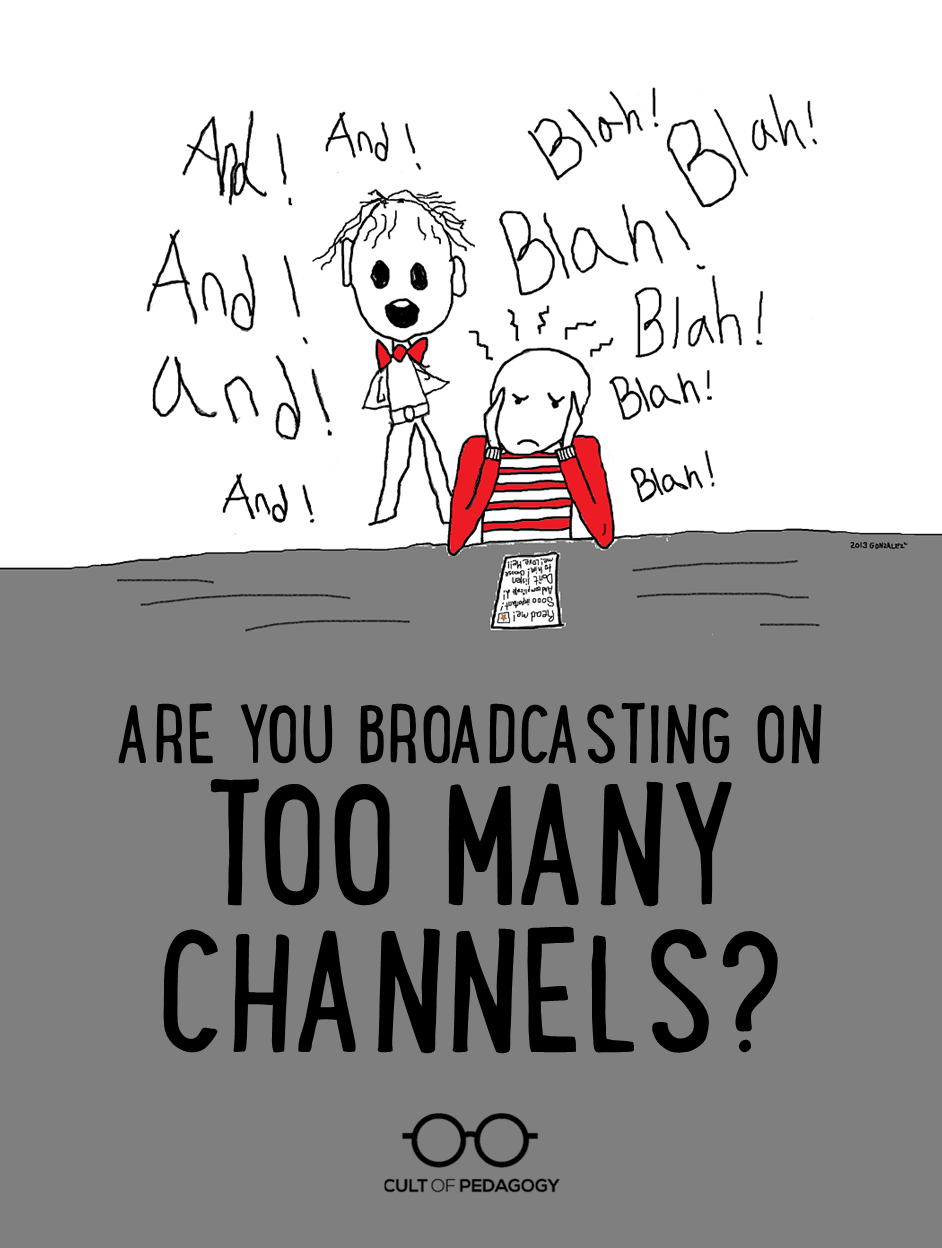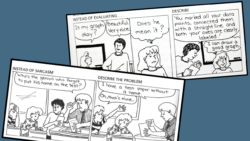Asking students to read one thing and listen to another is asking the impossible.
Picture this: You stand before a room full of students, holding a stack of handouts. Or worksheets. Or course syllabi. To the group, you say, “This paper is important. You need to read it carefully.” Then you distribute copies to everyone in the room.
And what do you do next?
You talk. And you talk. Talky-talky-talk-talk-TALK.
Meanwhile, your students are faced with a terrible choice: Either they read the document that has been placed before them, or they listen to you. They literally can’t do both. Despite our belief that we’re great at multitasking, the research says we’re actually pretty awful.
But we ask our students to do it all the time. And when we bombard them with data from two different channels, they will inevitably miss something, either the spoken stuff or the written stuff. Too often, we place the blame for this on students — sometimes with nasty results.
Like in this situation: You specifically told students to only do the front of a worksheet. After a few minutes, several of them flip it over and start completing the back side. This may have been caused by normal childhood forgetfulness or spacing out. But it could also be that while you were telling them to only write on the front side, some kids were totally immersed in reading that front side. Or looking at the pictures. Or examining the chart. You said it, yes, but some of them never heard it. Not realizing this, and feeling cranky, you may react like this: “It seems SOME of you weren’t listening. I just told you not to turn your papers over, but what do I see? Three papers turned over. Why don’t you listen?” If one of these three students is feeling similarly cranky, he may mutter something under his breath, which may prompt you to raise the stakes even more. Before you know it, you’ve got a discipline problem on your hands.
Also, let’s be fair and admit that it’s not just kids who can’t process two streams of information at once. Adult learners, participants in corporate training sessions, even teachers sitting in faculty meetings do the exact same thing. Regardless of age, your brain can only operate on one channel at a time.
Here’s another scenario: You hand out a writing prompt. The written instructions clearly state that students must use the attached rubric to score themselves when they are finished. But when the papers are turned in, a third of the class has left the rubric totally blank. HOW DARE THEY? The instructions were right in front of them. WHY DON’T THEY READ WHAT’S RIGHT IN FRONT OF THEM???
Okay, maybe some of them are lazy – that’s the assumption, right? But it’s also possible that when you handed out the prompt, you talked intermittently for 2 minutes, so that many students couldn’t really concentrate on the written instructions. When you finished talking, some kids felt like they’d read them – they definitely looked at the words, even though their concentration was broken. So once you stopped talking, they just got started, totally missing the part about the rubric.
Is this kind of cross-signal broadcasting inevitable? Sure. And shouldn’t students be re-reading instructions anyway? Yep. But if you make these two small changes, you can at least minimize the static that comes from you:
1. Hold off on showing text until it must be read. There’s no need to distribute a handout, have students open textbooks, or send them to a website if you still have a lot to say. Resist the temptation to get everything out there. Instead, make your introductory remarks before you ever show a document to students. If it’s already out there, you can simply ask students to turn it over, put it under their desks, or minimize their screen if you want some undivided attention. If you have a text-heavy PowerPoint on screen, cover up the slide using this neat trick: In slideshow mode, pressing “B” on your keyboard will instantly turn the screen black. Hit “B” again to return to the slideshow. “W” will get you a white screen instead. (If you watched last month’s video on Presentation Zen, you know your slides shouldn’t be loaded with words anyway, right?)
2. Provide time and quiet for important reading. Once you do give a document to students, kindly shut your yap. Tell them ahead of time that you’re going to wait a few minutes so they can read it, and that they should write down any questions they have, because you won’t allow any talking during the reading period. Then really stick to it. Silence like that can be uncomfortable if no one is used to it, but once you build it into your routine, the time will be put to good use.
We can’t get into our students’ brains and control every one of their thoughts — sometimes they just aren’t going to pay attention. But if we send out only one signal at a time, we can improve the odds that they’ll be able to. ♦
I would love to have you come back for more. Join my mailing list and get weekly tips, tools, and inspiration—in quick, bite-sized packages—all geared toward making your teaching more effective and joyful. To welcome you, I’ll be sending a free copy of my new e-booklet, 20 Ways to Cut Your Grading Time in Half. I look forward to having you join me.






I do this all the time. I pass out papers, keep talking and talking, and even awkwardly end with something like, “Ok, I’m going to shut up now so you can work.” Thank you for writing this post!
Ha! I just realized this was you. I pretty much ended my own chatter the same way.
For me the worst is when teachers in faculty meetings think that they can multi task. They should know better, but more often than not I will see teachers grading, on their phone, sorting out their diary…
And then they are surprised when they do not know what is going on.
To introduce a project, I give students access to criteria sheets and have them read them and write down the three most important things to know. Then we pair-share and then share out to the whole group. It gets the information out there but in a much more effective and student-involved way.